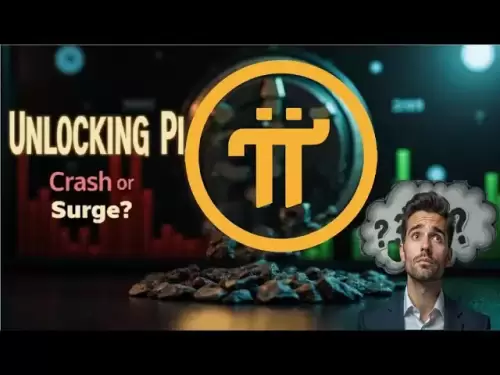-
 Bitcoin
Bitcoin $108,270.9768
2.07% -
 Ethereum
Ethereum $2,489.8066
2.50% -
 Tether USDt
Tether USDt $1.0004
0.01% -
 XRP
XRP $2.2035
0.66% -
 BNB
BNB $661.6608
2.32% -
 Solana
Solana $150.6425
2.13% -
 USDC
USDC $0.9999
-0.01% -
 TRON
TRON $0.2810
0.90% -
 Dogecoin
Dogecoin $0.1645
3.05% -
 Cardano
Cardano $0.5743
4.91% -
 Hyperliquid
Hyperliquid $38.8419
-0.15% -
 Bitcoin Cash
Bitcoin Cash $504.3134
-2.64% -
 Sui
Sui $2.8096
4.35% -
 Chainlink
Chainlink $13.3095
2.21% -
 UNUS SED LEO
UNUS SED LEO $8.9469
0.33% -
 Avalanche
Avalanche $17.9231
3.93% -
 Stellar
Stellar $0.2340
0.74% -
 Toncoin
Toncoin $2.8458
3.21% -
 Shiba Inu
Shiba Inu $0.0...01158
3.47% -
 Litecoin
Litecoin $86.0738
1.94% -
 Hedera
Hedera $0.1507
2.99% -
 Monero
Monero $319.8544
2.31% -
 Polkadot
Polkadot $3.4081
1.95% -
 Dai
Dai $1.0000
0.01% -
 Bitget Token
Bitget Token $4.5645
0.91% -
 Ethena USDe
Ethena USDe $1.0002
0.00% -
 Uniswap
Uniswap $7.2959
5.27% -
 Aave
Aave $272.4623
2.90% -
 Pepe
Pepe $0.0...09680
2.96% -
 Pi
Pi $0.4955
0.78%
OKX perpetual contract stop profit and stop loss tutorial
Stop-profit and stop-loss orders are crucial risk management tools in perpetual contract trading, allowing traders to protect profits and limit potential losses as market prices fluctuate.
Nov 19, 2024 at 10:40 pm

OKX Perpetual Contract Stop Profit and Stop Loss Tutorial
Introduction
Perpetual contracts are a popular type of derivative contract that allows traders to speculate on the price of an underlying asset, such as Bitcoin or Ethereum, without having to own the asset itself. One of the key features of perpetual contracts is the ability to use stop-profit and stop-loss orders to manage risk and protect profits.
Step 1: Understanding Stop-Profit and Stop-Loss Orders
- Stop-profit order: A stop-profit order is an order that is placed above the current market price for a long position, or below the current market price for a short position, with the intention of locking in a profit if the market price moves in the desired direction.
- Stop-loss order: A stop-loss order is an order that is placed below the current market price for a long position, or above the current market price for a short position, with the intention of limiting potential losses if the market price moves in the opposite direction.
Step 2: Placing a Stop-Profit Order
To place a stop-profit order on OKX:
- Log in to your OKX account and navigate to the perpetual contract trading page.
- Select the desired trading pair and click on the "Stop Profit" button.
- Enter the desired stop-profit price.
- Enter the desired quantity.
- Click on the "Place" button.
Step 3: Placing a Stop-Loss Order
To place a stop-loss order on OKX:
- Log in to your OKX account and navigate to the perpetual contract trading page.
- Select the desired trading pair and click on the "Stop Loss" button.
- Enter the desired stop-loss price.
- Enter the desired quantity.
- Click on the "Place" button.
Step 4: Managing Stop-Profit and Stop-Loss Orders
Once you have placed a stop-profit or stop-loss order, you can manage it by modifying or canceling the order.
- Modifying a stop-profit or stop-loss order: To modify a stop-profit or stop-loss order, simply click on the "Modify" button and make the desired changes.
- Canceling a stop-profit or stop-loss order: To cancel a stop-profit or stop-loss order, simply click on the "Cancel" button.
Step 5: Best Practices for Using Stop-Profit and Stop-Loss Orders
- Use realistic stop-profit and stop-loss prices: Your stop-profit and stop-loss prices should be based on technical analysis and your personal risk tolerance.
- Set stop-profit and stop-loss orders at logical levels: Place your stop-profit and stop-loss orders at logical levels, such as support and resistance levels.
- Don't be afraid to adjust stop-profit and stop-loss orders: Market conditions can change rapidly, so don't be afraid to adjust your stop-profit and stop-loss orders accordingly.
Disclaimer:info@kdj.com
The information provided is not trading advice. kdj.com does not assume any responsibility for any investments made based on the information provided in this article. Cryptocurrencies are highly volatile and it is highly recommended that you invest with caution after thorough research!
If you believe that the content used on this website infringes your copyright, please contact us immediately (info@kdj.com) and we will delete it promptly.
- NEOP and the Meme Coin Mania: A New Era of Crypto Investing?
- 2025-07-02 22:50:12
- SUI Rebound: Analyst Predicts Potential Price Targets for Explosive Move
- 2025-07-02 23:30:12
- Trump, Crypto, and Fortune: A Wild Ride in 2025
- 2025-07-02 23:30:12
- NodeOps, Network, Tokenomics: DePIN 2.0 is Here!
- 2025-07-02 23:35:12
- Dollar Coin Auction Mania: Are These Coins Really Worth the Hype?
- 2025-07-02 23:35:13
- Portugal Embraces Cryptocurrency Cloud Mining: A New Era with GMO Miner
- 2025-07-02 23:40:12
Related knowledge

How to identify the contract value range in combination with the market profile?
Jul 02,2025 at 10:56pm
Understanding the Market ProfileTo effectively identify the contract value range in combination with the market profile, it's essential to first understand what each concept entails. The market profile is a framework that helps traders visualize how price and time interact across a given period, typically a trading day or session. It provides insights i...

How to use the price slope to filter the false breakthrough signal of the contract?
Jun 20,2025 at 06:56pm
Understanding the Concept of Price Slope in Contract TradingIn contract trading, especially within cryptocurrency derivatives markets, price slope refers to the rate at which the price changes over a specific time period. It helps traders assess the strength and sustainability of a trend. A steep slope may indicate strong momentum, while a shallow slope...

How to determine the expected volatility of the contract through the volatility cone?
Jun 19,2025 at 12:28pm
Understanding the Basics of Volatility in Cryptocurrency ContractsIn the realm of cryptocurrency trading, volatility is a key metric that traders use to assess potential risk and reward. When dealing with futures contracts, understanding how volatile an asset might become over time is crucial for position sizing, risk management, and strategy developmen...

How to formulate a contract intraday trading plan in combination with the pivot point system?
Jun 21,2025 at 03:42pm
Understanding the Basics of Pivot Points in Cryptocurrency TradingPivot points are technical analysis tools used by traders to identify potential support and resistance levels. These levels are calculated using the previous day's high, low, and closing prices. In the context of cryptocurrency trading, where markets operate 24/7, pivot points help trader...

How to adjust the contract position ratio through the price fluctuation entropy?
Jun 22,2025 at 11:42am
Understanding Price Fluctuation Entropy in Cryptocurrency ContractsIn the world of cryptocurrency futures trading, price fluctuation entropy is a relatively new concept used to measure market volatility and uncertainty. It derives from information theory, where entropy refers to the degree of randomness or unpredictability in a system. In crypto contrac...

How to use the volume swing indicator to predict the contract volume-price divergence?
Jun 18,2025 at 11:42pm
Understanding the Volume Swing IndicatorThe volume swing indicator is a technical analysis tool used primarily in cryptocurrency trading to evaluate changes in volume over time. Unlike price-based indicators, this metric focuses solely on trading volume, which can provide early signals about potential market reversals or continuations. The key idea behi...

How to identify the contract value range in combination with the market profile?
Jul 02,2025 at 10:56pm
Understanding the Market ProfileTo effectively identify the contract value range in combination with the market profile, it's essential to first understand what each concept entails. The market profile is a framework that helps traders visualize how price and time interact across a given period, typically a trading day or session. It provides insights i...

How to use the price slope to filter the false breakthrough signal of the contract?
Jun 20,2025 at 06:56pm
Understanding the Concept of Price Slope in Contract TradingIn contract trading, especially within cryptocurrency derivatives markets, price slope refers to the rate at which the price changes over a specific time period. It helps traders assess the strength and sustainability of a trend. A steep slope may indicate strong momentum, while a shallow slope...

How to determine the expected volatility of the contract through the volatility cone?
Jun 19,2025 at 12:28pm
Understanding the Basics of Volatility in Cryptocurrency ContractsIn the realm of cryptocurrency trading, volatility is a key metric that traders use to assess potential risk and reward. When dealing with futures contracts, understanding how volatile an asset might become over time is crucial for position sizing, risk management, and strategy developmen...

How to formulate a contract intraday trading plan in combination with the pivot point system?
Jun 21,2025 at 03:42pm
Understanding the Basics of Pivot Points in Cryptocurrency TradingPivot points are technical analysis tools used by traders to identify potential support and resistance levels. These levels are calculated using the previous day's high, low, and closing prices. In the context of cryptocurrency trading, where markets operate 24/7, pivot points help trader...

How to adjust the contract position ratio through the price fluctuation entropy?
Jun 22,2025 at 11:42am
Understanding Price Fluctuation Entropy in Cryptocurrency ContractsIn the world of cryptocurrency futures trading, price fluctuation entropy is a relatively new concept used to measure market volatility and uncertainty. It derives from information theory, where entropy refers to the degree of randomness or unpredictability in a system. In crypto contrac...

How to use the volume swing indicator to predict the contract volume-price divergence?
Jun 18,2025 at 11:42pm
Understanding the Volume Swing IndicatorThe volume swing indicator is a technical analysis tool used primarily in cryptocurrency trading to evaluate changes in volume over time. Unlike price-based indicators, this metric focuses solely on trading volume, which can provide early signals about potential market reversals or continuations. The key idea behi...
See all articles

























































































